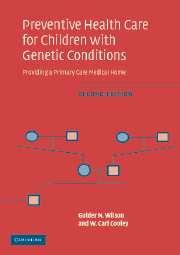Book contents
- Frontmatter
- Contents
- Preface
- Glossary of genetic and molecular terms
- Part I Approach to the child with special needs
- Part II The management of selected single congenital anomalies and associations
- Part III Chromosomal syndromes
- Part IV Syndromes remarkable for altered growth
- Part V Management of craniofacial syndromes
- Part VI Management of connective tissue and integumentary syndromes
- Part VII The management of neurologic and neurodegenerative syndromes
- Part VIII Management of neurodegenerative metabolic disorders
- References
- Index
Part II - The management of selected single congenital anomalies and associations
Published online by Cambridge University Press: 29 January 2010
- Frontmatter
- Contents
- Preface
- Glossary of genetic and molecular terms
- Part I Approach to the child with special needs
- Part II The management of selected single congenital anomalies and associations
- Part III Chromosomal syndromes
- Part IV Syndromes remarkable for altered growth
- Part V Management of craniofacial syndromes
- Part VI Management of connective tissue and integumentary syndromes
- Part VII The management of neurologic and neurodegenerative syndromes
- Part VIII Management of neurodegenerative metabolic disorders
- References
- Index
Summary
The average newborn has a 2–3% chance to have a major congenital anomaly, twothirds with isolated defects like cleft palate and one-third with patterns of defects (sequences, associations, or syndromes). Paralleling this frequency of structural defects, and exaggerated when they are present, are risks for abnormal brain development that manifest as behavior differences and/or cognitive disability. These children, defined by an IQ two standard deviations below normal or less than 70, will also constitute 2–3% of the population. The result is a 5% chance for physical and/or mental disability in children old enough for assessment, and their increased clinical care ensures that every health care professional will devote much time to children with special needs. This section begins translation of principles from Chapters 1 to 3 into management strategies for specific disabling conditions.
Chapters 4 and 5 will discuss congenital disorders that have no associated birth defects (like some cases of cerebral palsy) or lack the stereotypical and recognizable patterns of anomalies that characterize genetic syndromes. Cerebral palsy encompasses a large group of disorders defined by a typical pattern of neurologic dysfunction; it is a category like autism spectrum disorders where DNA technology is demonstrating an increasing etiologic role for genes as compared to perinatal or environmental influences. Hydrocephalus and spina bifida also have genetic predisposition, but are like cerebral palsy in forcing attention to neuromotor function rather than internal defects or genetic testing.
- Type
- Chapter
- Information
- Preventive Health Care for Children with Genetic ConditionsProviding a Primary Care Medical Home, pp. 59 - 60Publisher: Cambridge University PressPrint publication year: 2006

